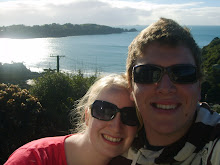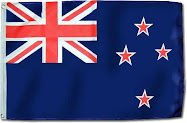Population: 4 million
Capital: Wellington
Major languages: English, Maori
Major religion: Christianity
Life expectancy: 76 years (men), 81 years (women)
Monetary unit: 1 New Zealand dollar ($NZ) = 100 cents
Main exports: Wool, food and dairy products, wood and paper products
Internet domain: .nz
International dialling code: +64
New Zealand lies in the southern Pacific Ocean, 1600 km east of Australia. It is made up of the North and South Islands and a number of smaller islands, with a total area of 268 000 sq km. Mountain ranges and hill country dominate NZ's landscape; one of the most striking physical features is the Southern Alps. These, along with fiords glaciers and lakes and the coastal plains of Canterbury and Southland add to the variety of the South Island scenery.
In the North Island the volcanic interior contains NZ's largest lake, Lake Taupo, and most of the country's active volcanoes - Ruapehu, Ngauruhoe and Tongariro - Ruapehu erupted as recently as 1995 and 1996. Hot springs, geysers, mud pools also form part of the volcanic system centred around Rotorua.
Polynesians settlers arrived in Aotearoa/New Zealand around the tenth century, and by the twelfth century settlements were scattered over most of the country.
What the Polynesians found was a land much different to the South Pacific tropical isles of Polynesia. Instead they found a land of mountains with a more seasonal climate. There were no large mammals to hunt for food, but there was a large flightless bird called the Moa. The Moa stood up to 15 feet tall and the Maori found it easy prey. By the time Europeans had reached New Zealand the Moa was hunted to extinction.
Abel Janzoon Tasman was the first European explorer to see New Zealand in 1642, but it was Captain James Cook who first set foot on New Zealand soil in 1769.
The first permanent settlers didn't arrive until the 1830's. The Treaty of Waitangi was signed in 1840, giving sovereignty of New Zealand to Britain. The Maori were persuaded to cede vast tracts of land for mere token payments, but soon the Maori realised the true worth of what they had given away. The Maori rose up and attacked the British settlements repeatedly.
Today New Zealand is a relatively peaceful country and the people are extraordinarily friendly and outgoing. One quarter of New Zealand is protected wilderness and much of the country is pollution free.
Geography and Climate
New Zealand is located in the southern Pacific Ocean, approximately 1,600 kilometres (995 miles) south-east of Australia. New Zealand is comprised of two main islands (the North and South Islands) and several smaller islands of which the combined total land area is 270,534 sq. kms (104,454 sq. mls - approximately 36 times less than the US). It is similar in size to Colorado and somewhere in between the size of Japan and the United Kingdom.
New Zealand's geography includes spectacular landscapes incorporating the vast mountain chain of the Southern Alps (larger than the French, Austrian and Swiss Alps combined), the volcano region of the North Island, fiords, glaciers, lakes, rainforests and extensive grassy plains.
Highest point: Mount Cook (3,754 m or 12313 ft)Deepest lake: Lake Hauroko (462 m 1515 ft)Largest lake: Lake Taupo (606 km or 234 miles)Longest river: Waikato River (425 km or 264 miles long)Largest glacier: Tasman Glacier (29 km or 18 miles long)Deepest cave: Nettlebed, Mount Arthur (889 m or 2916 ft)Length of coastline: 15,811 km (9824 miles)
New Zealand experiences summer from December - February and winter from June - August. The climate is temperate with little extreme. Any huge variations in temperature can be accounted for by the combination of the mountainous geography and prevailing westerly winds.
New Zealand is an independent state of the Commonwealth. The Queen is represented in New Zealand by the Governor General, The democratic government operates under the Mixed Member Proportional (MMP) Parliamentary system of 120 seats (of which 67 Members of Parliament are from geographic areas and 53 from political parties). The Government is led by coalition partners - the Labour Party and United Future. The Prime Minister of New Zealand is the Right Honorable Helen Clark.
Leisure & Tourism
New Zealanders are heavily involved in outdoors activities. Our national image and the lifestyles of the population have been largely shaped by our involvement in a wide variety of sports and leisure activities. It is often said that sports and leisure are the predominant focus of the New Zealand cultural identity, for example, New Zealand's involvement in international rugby. New Zealand is a popular holiday destination for visitors from Australia, North America, the United Kingdom and Japan.
Primary Production
Agriculture and horticulture, forestry, fisheries, energy and minerals are the primary natural resources of New Zealand. The most valuable of these product groups, providing a high proportion of New Zealand's export earnings is agriculture and horticulture which incorporates the production of sheepmeat, beef, wool, dairy produce and hides, deer, goats and cereal products. In fact, agricultural products total more than 50% of all New Zealand exports.
Industry & Business
While New Zealand's primary manufacturing industries are the food processing industry (meat and dairy etc) and the engineering sector, New Zealand has an increasingly strong competitive advantage in food processing technology, telecommunications, plastics, textiles, plantation forest products, electronics, climbing equipment and apparel. In recent years there has also been a far greater interest in the production of specialised lifestyle products such as yachts.
Economy
New Zealand's economy is heavily dependent on overseas trade. Traditionally a large proportion of New Zealand's exports, (mainly agricultural products), go to the United Kingdom.
New Zealand has developed its agriculture and manufacturing industries to suit the needs of niche markets. Dairy and meat exports still make a large contribution to New Zealand's economy. However, industries such as forestry, horticulture, fishing, manufacturing and tourism have become increasingly significant.
Australia is now our number one merchandise export market. The United States has increased its share to become our second largest export market, followed by Japan, and in fourth place the United Kingdom. .
The New Zealand currency is the New Zealand dollar. One dollar is equal to 100 cents.
Monday, March 3, 2008
Subscribe to:
Post Comments (Atom)


No comments:
Post a Comment